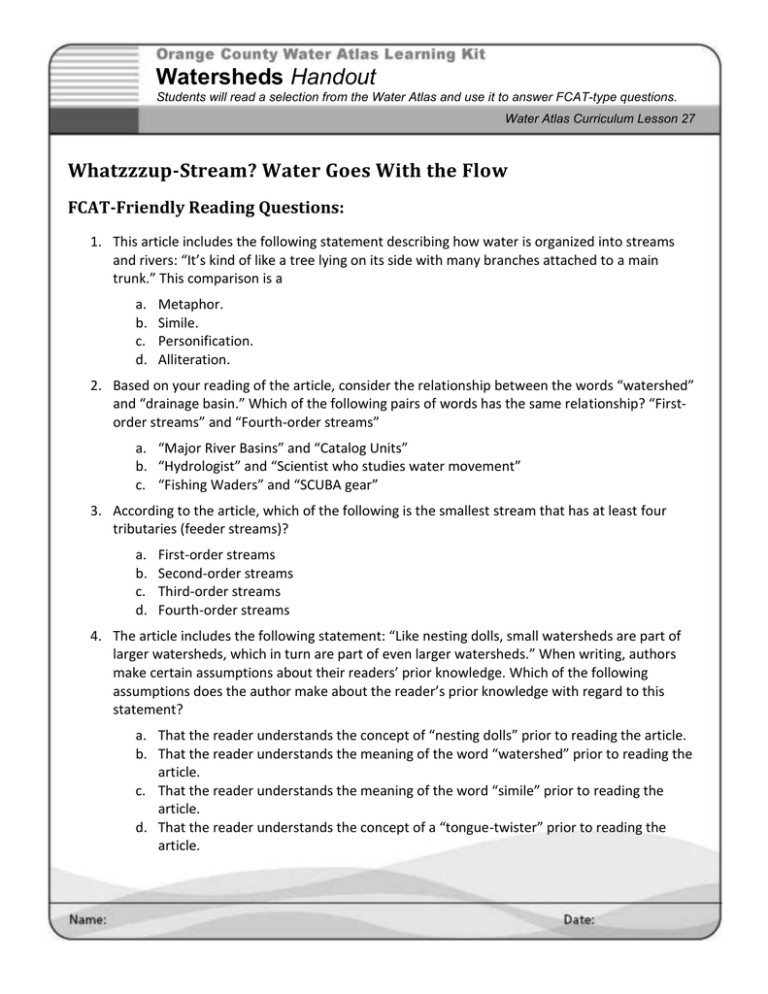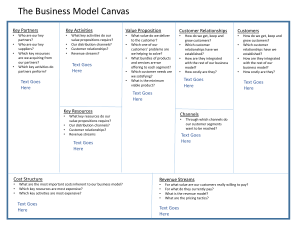Watersheds
advertisement

Watersheds Handout Students will read a selection from the Water Atlas and use it to answer FCAT-type questions. Water Atlas Curriculum Lesson 27 Whatzzzup-Stream? Water Goes With the Flow FCAT-Friendly Reading Questions: 1. This article includes the following statement describing how water is organized into streams and rivers: “It’s kind of like a tree lying on its side with many branches attached to a main trunk.” This comparison is a a. b. c. d. Metaphor. Simile. Personification. Alliteration. 2. Based on your reading of the article, consider the relationship between the words “watershed” and “drainage basin.” Which of the following pairs of words has the same relationship? “Firstorder streams” and “Fourth-order streams” a. “Major River Basins” and “Catalog Units” b. “Hydrologist” and “Scientist who studies water movement” c. “Fishing Waders” and “SCUBA gear” 3. According to the article, which of the following is the smallest stream that has at least four tributaries (feeder streams)? a. b. c. d. First-order streams Second-order streams Third-order streams Fourth-order streams 4. The article includes the following statement: “Like nesting dolls, small watersheds are part of larger watersheds, which in turn are part of even larger watersheds.” When writing, authors make certain assumptions about their readers’ prior knowledge. Which of the following assumptions does the author make about the reader’s prior knowledge with regard to this statement? a. That the reader understands the concept of “nesting dolls” prior to reading the article. b. That the reader understands the meaning of the word “watershed” prior to reading the article. c. That the reader understands the meaning of the word “simile” prior to reading the article. d. That the reader understands the concept of a “tongue-twister” prior to reading the article. Watersheds Handout Students will read a selection from the Water Atlas and use it to answer FCAT-type questions. Water Atlas Curriculum Lesson 27 FCAT-Friendly Writing Prompts: 1. Water flows from smaller streams towards larger streams, rivers, and oceans. Imagine that you are a single drop of water in this flow. Write to explain three things you might experience as you progress into larger and larger bodies of water. 2. Some professions that deal with water include studying the flow of streams, teaching about the environment, creating maps of waterways, and controlling erosion problems. Think about which of these careers would be most appropriate for you. Write to persuade your guidance counselor that this career choice is right for you. 3. Most Americans live within ten miles of a polluted body of water. Think about a time you saw pollution on water or land. Write to explain the form of pollution you saw and how you felt when you saw it. 4. When pollution enters the environment, rain carries it to the nearest ditch or stormwater drain, where it flows downstream into a larger body of water. Imagine that you see a neighbor pouring used car oil into a ditch or storm drain. Write to persuade him or her that these actions are damaging a much larger area. Watersheds Handout Students will read a selection from the Water Atlas and use it to answer FCAT-type questions. Water Atlas Curriculum Lesson 27 FCAT-Friendly Math Questions: The Orange County Water Atlas Website houses data about watersheds and the water bodies that make them up. Some kinds of information are collected for each water body. Data about water level, for example, is collected at several spots along the St. Johns River. The water level data in the table below was collected from the St. Johns River Watershed. Rainfall information, on the other hand, is not collected at each water body. Instead, the data points are watershed-wide values (each an average from several rain gauges in the watershed). Date Aug-03 Sep-03 Oct-03 Nov-03 Dec-03 Jan-04 Feb-04 Mar-04 Apr-04 May-04 Average Feet above Sea Level (Water Level) 5.26 6.02 5.49 3.73 1.94 1.22 1.69 1.89 0.71 0.37 Average Rainfall (Inches) 0.01 0.16 0.59 0.07 0.01 0.04 0.10 0.03 0.05 0.03 1. Based on the data in the table, what was the total rainfall from August 2003 – May 2004 expressed in centimeters? [1 inch = 2.54 cm] a. 1.09 cm b. 2.77 cm c. 28.32 cm d. 71.93 cm 2. Based on the data in the table, what was the average water level from September 2003 through December 2003? a. b. c. d. 0.11 feet above sea level 0.21 feet above sea level 2.83 feet above sea level 4.30 feet above sea level



